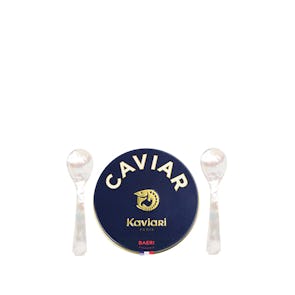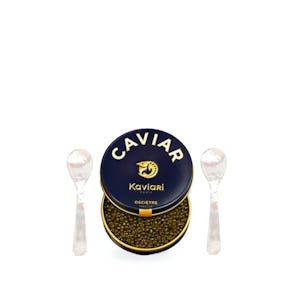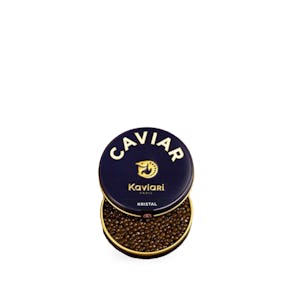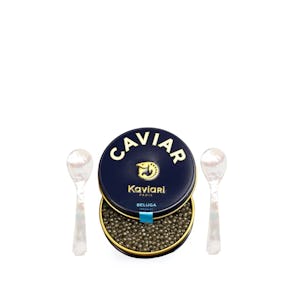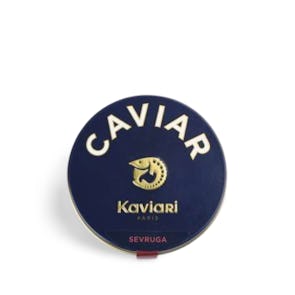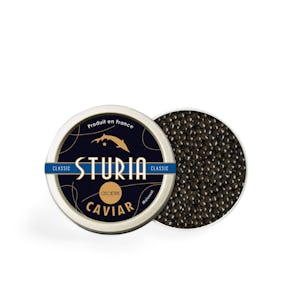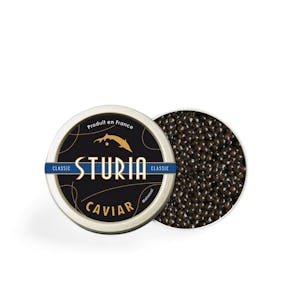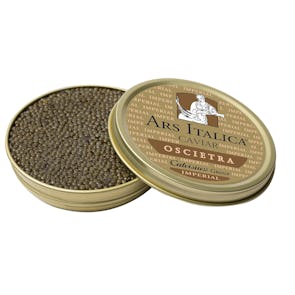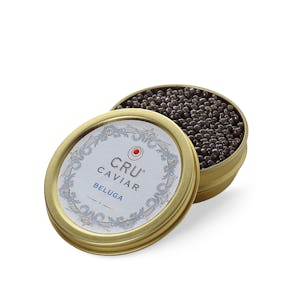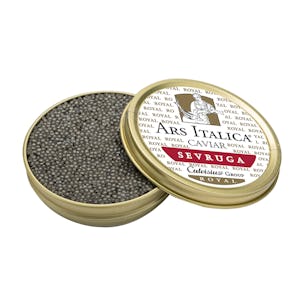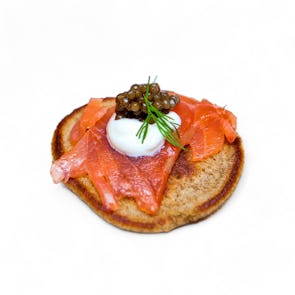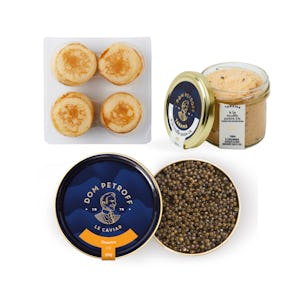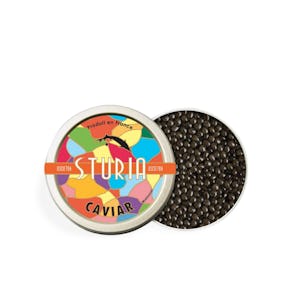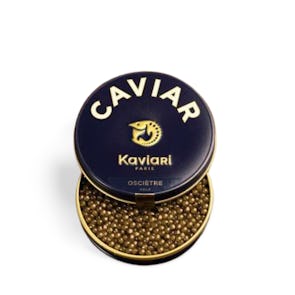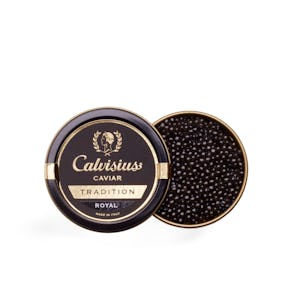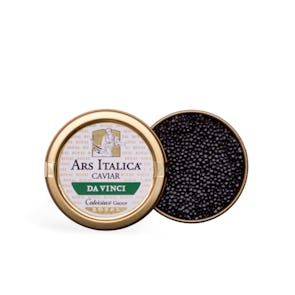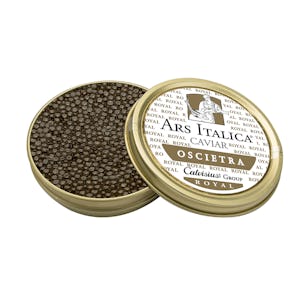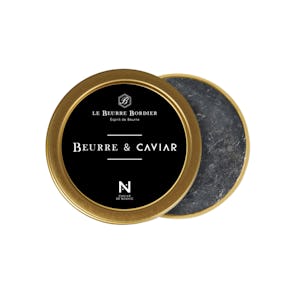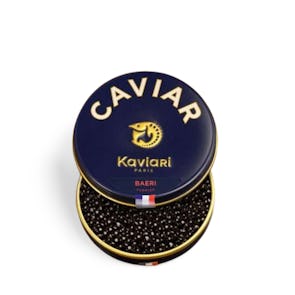- Categories
- Brands
- Origin
- Sort by: Recommended
Caviar
Delivered in Metro Manila and neighbouring cities, Cebu, Bacolod and Davao
What is Caviar?
Caviar is a gourmet delicacy enjoyed all over the world, similar to Champagne, fresh oysters, foie gras, and truffles. Caviar was one of the very first delicacies, coveted by kings and the aristocracy. It consists of salt-cured roe, which is what you call the eggs of a fish.
Where does Caviar come from?
Caviar comes from wild sturgeon found in the Caspian Sea and the Black Sea. Russia and Iran used to be top of the game, but the modern-day caviar industry leader is China, taking up about 60% of world caviar production. They’re followed closely by Italy and France.
Many caviar producers have been relying on farming caviar, in attempts to preserve endemic species, like the European sturgeon (Acipenser sturio) in France, the white sturgeon (Acipenser transmontanus) in the USA, the Kaluga in China, and the Adriatic sturgeon in Italy.
And there are special cases like Uruguay, a country with no local sturgeon presence, that set up sturgeon farms on the banks of the Rio Negro, and is now Latin America’s number one caviar exporter.
How is Caviar harvested?
Traditionally, the sturgeon is killed to obtain its roe. Many producers still use this method, as it is still the best way to ensure freshness and pure flavor. It’s also one of the reasons caviar is priced the way it is, because sturgeons take about a decade or so to mature and have eggs, so it’s basically non-renewable.
Modern technology, though, has developed more sustainable methods that many companies employ. But no matter the method of their extraction, the eggs or roe are always removed by hand with great meticulousness. After being harvested, the roe is screened for quality. Then comes the preparation, where they are rinsed to wash away impurities, before salt is added in precise amounts for taste and preservation. Then they are graded, and carefully packed in lacquer-lined tins.
What is True Caviar?
There are many products labeled “caviar” on the market, but what counts as true caviar? Traditionally, true caviar is unpasteurized roe that comes specifically from sturgeons.
The American FDA, though, counts any fish eggs that are specially prepared as “caviar,” although manufacturers must place on the label the name of the fish whose roe they used. So be aware of that distinction. There is a diverse number of caviar options, but true caviar only comes from sturgeon.
What does Caviar taste like?
Such a curious looking dish will, of course, have you wondering what it tastes like. Good, high quality caviar is mild and fresh in flavor, with a subtle saltiness and brininess. It’s not overpowering on the palate, and it gives off a pleasantly unexpected buttery sort of richness. Its texture is an experience in itself. The bead-like roe will roll and slide across your tongue and the roof of your mouth. It should be firm and smooth, with no distinct oiliness. And when you bite into the beads, it will give off a nice pop and release a burst of flavor.
What is Beluga Caviar?
Beluga caviar is the most expensive caviar sold on the market. It comes from the rare beluga sturgeon (Huso huso) found in the Caspian Sea, which is bordered by Iran, Russia, Kazakhstan, Azerbaijan, and Turkmenistan. It’s also farmed, mainly in Bulgaria. It’s the most famous caviar in the world, and the rarest and most sought-after. Beluga caviar also has the highest nutritional value of all the caviars, and has the biggest individual egg size. Its aroma is elegant and rich, barely having a fishy odor, and its taste is beautifully buttery, with creamy, nutty notes.
Why is Caviar considered a luxury item?
Caviar originated from Persia, which is now modern-day Iran, and first prepared and enjoyed by Persians. The word “caviar,” comes from the Persian word, “khavyar” (pronounced as written), which means “cake of strength,” or “cake of power,” as they attributed many medicinal powers to caviar.
It was first recorded in 4th century BC by Greek scholar, Aristotle, where he tells of this delicacy entering banquets accompanied by trumpets and flowers. It was catapulted to the world of luxury by Russian tsars, who enjoyed a type of golden roe from the Sterlet sturgeon, and was regarded as “imperial caviar,” and served to Russian, Austrian, and Iranian royalty. Caviar eventually made its way across Europe, where one jar cost about one hundred sheep in 2nd century BC, making it exclusive to higher class citizens.
How much is Caviar?
The price of caviar depends on a great number of considerations. From type of fish, to quality of roe, to harvesting and manufacturing processes, to consumer demand. Generally, you can expect to shell out at least about $65 (~₱3,000) for 30 grams of sturgeon roe, with the higher quality ones starting at about $100 (~₱5000). If you see caviar on a restaurant menu, the price can go even higher, with caviar service costing around $100.
How much is Caviar in the Philippines?
Caviar, which is “puga” or “bihud” in Tagalog, is sold in specialty stores around the Philippines, both online and brick-and-mortar. Caviar in the Philippines has a price range of about ₱2,500 to ₱23,000.
Why is Caviar expensive?
Caviar is priced the way it is for a number of reasons. Some cost factors when it comes to caviar are:
- The type of fish, and its availability. The rarer the fish, the more expensive the product
- The time it takes for the fish to produce roe. A female sturgeon generally takes around 10 to 15 years before maturation and production of eggs, which means the waiting game and caring for the fish can be costly
- The harvesting and manufacturing of the roe
- The quality of the salted roe. Roe is graded, but it does not necessarily mean that one grade is better than the other. Grade 1 is given to roe that are large and firm, intact but delicate, with a fine, even color and mild flavor. Grade 2 is for roe that is usually smaller, with more tanginess in its flavor.
- The supply and demand in accordance with the consumer market
The combination of it being rare, non-renewable, and in high demand is the main reason caviar costs the way it does.
What is the most expensive Caviar in the World?
With its price comparable to that of a precious gemstone, the Almas caviar is the most expensive caviar in the world. Its name, almas, means “diamond” in Russian, and both its look—golden in color, and its value, are reminiscent of the prized stone.
Almas caviar comes exclusively from the albino beluga sturgeon living in the Caspian Sea, mostly in the unpolluted waters near Iran. Beluga sturgeons are already rare, albino beluga sturgeons even more so. These sturgeons are also between 60 to 100 years of age when their eggs are harvested. As the sturgeon grows older, their eggs become smoother, more aromatic, and more elegant.
Almas is distinct in character, delicious, with a spongier texture. It’s complex, richly nuanced, with an intense nutty, creamy taste. It also comes in a special metal tin that is covered in 24-karat gold, making it perfect for a unique gift. A kilo of Almas caviar can cost at least $25,000 (~₱1.2 million).
How do you serve Caviar?
Serving caviar can be considered an artform in itself. Traditionally, mother-of-pearl or gold dish and utensils are used to serve it. The Russian way of serving is usually without ice. In Europe, it is served in a special caviar bowl on a bed of crushed ice.
Alternatives to the mother-of-pearl and gold are glass, bone, and sometimes, wood. Avoid using silver and metallic bowls and utensils, as these can cause oxidation and alter and impair the taste of the caviar. It is also not recommended to transfer caviar from the tin to a serving bowl because the eggs are very delicate, and might break. Fine caviar must also be served at a very cold temperature, at 26 to 35F, or 0 to 4C. Caviar is also usually served as an appetizer, as it has an extraordinary and rich combination of flavors itself, which may affect a main course dish.
What is a Caviar Spoon?
Because metal can cause oxidation, it is customary that caviar should not be served nor eaten with anything made of metal or silver, as it may spoil the taste of your delicacy. You may have noticed, though, that caviar is stored and sold in metal tins. These tins are lined with non-reactive interior linings to prevent contact with the caviar itself.
Traditionally, caviar spoons are made out of inert—or non-reactive—materials, like mother-of-pearl, gold, animal horn, bone, or wood. Plastic can even be used. One is not necessarily better than another, what is important is the spoon’s non-reactive nature. Although, let’s admit it, eating off a gold or pearl spoon is infinitely more luxurious, and just goes with the overall feel of the delicacy.
How much Caviar is a serving size per person?
If you’re sharing, about half to one ounce (14 to 28 grams) of caviar per person, would suffice. Remember to serve it cold. Traditionally, it is considered uncouth to take more than a spoonful of caviar at a time. Take small bites, maybe smaller than a tablespoon. Not only is it more polite, but it will also allow you to truly savor this fine delicacy, letting a nice little explosion of flavor burst on your palate.
If you are enjoying different types of caviar, serve them in order of taste or flavor intensity. Begin with the mildest caviar and work your way to the more intense.
What food do you pair with Caviar?
Caviar connoisseurs will insist that the best way to eat this gourmet roe is on its own, to truly appreciate all the flavor and complexity the caviar offers. But of course, however you eat it comes down to a matter of preference and taste. Some people can find caviar to be a bit too potent, and accompanying it with other foods is perfectly acceptable. In fact, there are foods that are considered traditional to serve alongside caviar.
The classic Russian way is to serve and eat caviar with blinis, which are small Russian pancakes. Another popular way to enjoy caviar is on some dry toast very lightly smeared with unsalted butter, or on dry, unsalted crackers.
There are also the conventional garnishes, like crème fraiche, lemon wedges, crumbled hard-boiled eggs, sour cream, diced onions, mini potatoes, and fresh herbs. These, combined with caviar, can give you a great gustatory experience.
If you want to go all out, you can also serve caviar on top of fresh oysters — a guaranteed special and opulent experience.
No matter how you decide to enjoy this delicacy, remember to keep the caviar the star of your meal. Don’t overpower it with too many contrasting flavors, but also try not to add so much of it in one go. It’s the Queen of Feasts, and deserves to be treated as such.
What drinks do you pair with Caviar?
Drink pairings can make or break a dining experience, and caviar is particularly picky on this front. You can use wine, of course, but make sure to pick high quality wine. Wines like Sauvignon Blanc go well with the less fancy caviars, like white sturgeon. True caviar goes well with Blanc de Noir or Chardonnay.
But if you want a truly incredible experience, vodka or Champagne is the way to go.
The Russians knew what they were doing when they paired vodka with this salted roe delicacy. It’s a perfect pairing, as the rich, salty flavor notes of the caviar are accentuated by the crisp booziness of pure vodka. Just make sure the vodka is very cold, and as pure and classic as you can get (avoid additives and flavorings). Wheat and rye-based vodka go exceptionally well with Ossetra caviar, in particular.
If there ever was a golden food combination, it would be caviar and Champagne. The high acidity of the drink complements the texture of the caviar so well. Add to that, the crackling of the caviar in the mouth is similar to the sparkling feeling Champagne has, so enjoying them together is a true gastronomic delight. Make sure, though, that you avoid semi-sweet or sweet Champagne, as it is the acidity that makes it a good complement. The drier the Champagne, the better, so Brut is best.
In fact, for a very special occasion, you can try caviar on fresh oysters, paired with Champagne. It will have you feeling like royalty yourself.
What are other ways to eat Caviar?
The best way to eat caviar is still on its own, with only a few accompaniments, and we encourage you to try it this way first. But that doesn’t mean that it is the only way to enjoy it.
There are many unconventional ways to consume caviar, especially when you want to add a hint of luxury to your meals. You can have it on pasta; a lemon capellini with a dollop of caviar is incredible. Fancy up your breakfast with a plate of buttery, creamy scrambled eggs topped with sour cream, herbs, and a spoonful of caviar.
If you prefer something besides blinis or crackers to put caviar on, you can put it on potato chips. Yes, potato chips. The combination of the crispy salty chips and the briny, creamy caviar is surprisingly pleasant. You can also have it on flat bread with some smoked salmon, crème fraiche, and chives.
What are the health benefits of Caviar ?
This gourmet food is good for your tastebuds, and good for your body. Aside from being considered an aphrodisiac, caviar is loaded with Omega-3, which boosts cardiovascular and brain health. It’s also rich in Selenium, an antioxidant that helps protect cells from free radicals, and helps with thyroid health.
It’s a great source of protein, and contains Vitamins A, C, E, and B12, the latter being essential to the production of red blood cells. It also contains zinc, calcium, magnesium, and ion. True caviar is also organic, containing no pesticides, additives, hormones, or antibiotics.
How do you choose with Caviar to buy?
Choosing a caviar to buy can be a little daunting, but it truly all boils down to personal tasting preferences. Remember that price is determined mostly by the size of the beads, complex manufacturing techniques, and rarity. The most expensive tin may not necessarily be the best one for you, as it really does depend on if you want something on the mild side, or one with more intense flavor. Here are some things to consider before picking a fish and brand:
- How many people will be enjoying the caviar, so you don’t buy too much. This is a perishable good, and although it will be fine after a day in the refrigerator, it is still best to consume it immediately.
- The occasion: is it a special one? An anniversary, perhaps? You can opt for the higher quality ones for that. A simple, elegant dinner party with a small crowd could do with something cheaper (in price, but never quality), so you can buy a little more without burning a hole through your pocket. And if it is for a solo, self-care day (and you deserve it), pick a caviar suited to your taste preference, and maybe grab a bottle of Champagne, too.
As for brands, Bow Tie Duck has a great line-up ready for you. We have Kaviari, Dom Petroff, and Faye, all of which work with quality farms around the world, curating only the best caviars for you. And we have Prunier, Riofrìo, and Polanco, which are more farm-to-table, getting their caviar from their own farms.
Bow Tie Duck also has a great variety in terms of fish. We have the incredible and prestigious Beluga Caviar, which you might prefer if you want to try the most famous type of caviar—bigger pearls with buttery, nutty flavor. We also offer Ossetra, the most popular caviar, and is great for those preferring something buttery and briny. You can also find Kaluga (or Amursky or Kristal) on our site, if you’re interested in a delicacy that has a little bit of an earthy undertone to its flavor. We offer Baeri too, for those who want that burst of incredible and pure briny flavor on their tongue. And of course, we have White Sturgeon (transmontanus), for those curious in a mild, buttery caviar with floral notes.
Where to buy Caviar in Manila, Philippines?
You can shop for caviar right here on Bow Tie Duck. We offer quite a range of incredible options and brands, from Oscietra to Beluga to White Sturgeon. We offer brands like Kaviari (from France), Polanco (from Uruguay), Prunier (from France), and many others. We also take care of delivery, making sure you get your caviar in great condition right at your doorstep.
If you have any questions, or you want advice on what to buy, we are at your service every day, any time, from early in the morning to late in the evening. Contact us by email or by chat, and let us handle things for you.

